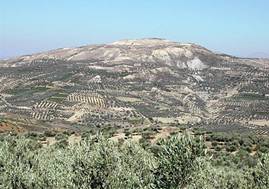Impacts of land degradation on the livelihood of people and what groups are most affected
Land degradation and desertification are processes characterised by the deterioration in land quality in terms of its capability to functionally support a selected land use and associated flora and fauna. Desertification may be considered as extreme land degradation where land loses much of its natural productivity. Areas highly affected from desertification in Crete are olive groves, vineyards and pastures. Pastures were mainly characterized as to critical areas to desertification with shrubby vegetation, spare deciduous oak and evergreen oak forests. Today, a large number of animals such as sheep, goats, and cows are scattered throughout in the hilly and mountainous areas overgrazing the land. The result of this type of land management is land degradation due to soil erosion (Figure 30). Therefore, the amount of grass growing is not enough to satisfy the needs of the grazing animals. Farmers have to supply large amounts of animal feed transported from other areas in order to compensate the low land productivity. An additional amount of animal feed ranged from 200 kg to 280 kg ha-1 depending on the degree of land degradation. Therefore, shepherd's income is highly reduced affecting their level of life.
Figure 31: Highly degraded and desertified grazing land (left) and olive groves in a fragile area to desertification (right)
Olive groves are mainly cultivated in areas characterized as fragile or potential to desertification. A field survey of the type of environmentally sensitive areas and the olive production have shown that olive oil production is reduced linearly as the stage of land desertification. The average olive oil production decrease from 1850 kg ha-1 to 650 kg ha-1 as the type of ESA changed from non-threatened to critical. Efforts are made to increase production by irrigating the land but farmers face severe problems of water shortage. A large pressure is exerted on ground water resources due to continuously increased demands for water consumption. The over-exploitation of aquifers has reduced the amount and the quality of water allocated to the agriculture with adverse consequences to the low land areas which are irrigated. Low profitability due to low market prices, climatic events such as drought and frost, competition from markets in other countries all lead to low farmer's income. In some cases people cannot survive under such circumstances and land is abandoned followed by migration of local people.

